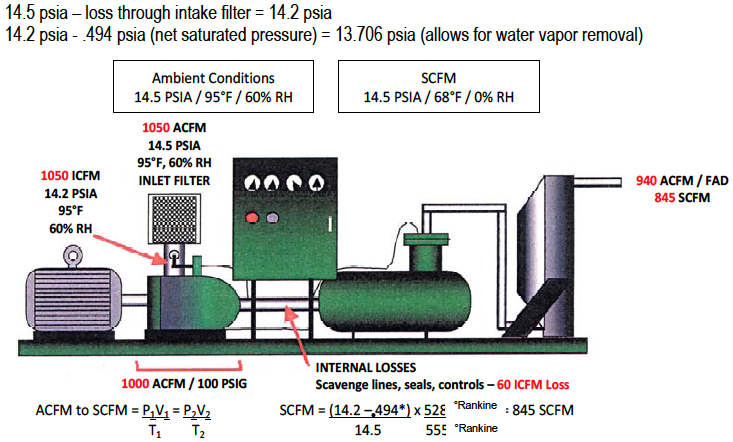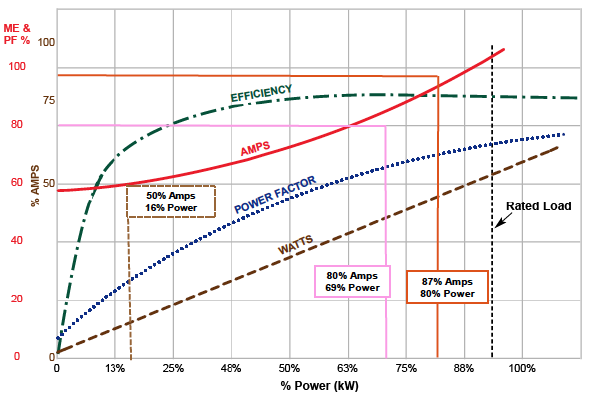In general, this article focuses on the definitions of terms often used to understand centrifugal air compressor performance. Comments are also made on how to measure power consumption. This article is not intended to be an engineering discussion of the various types and designs of centrifugal and other air compressors.
Compressor Capacity Definitions
Following are some clarifying definitions of terms used, and often misused, to define capacity or flow in centrifugal compressors.
Capacity is the quantity of air at which the compressor will operate at a specific discharge pressure. For all industrial compressors, capacity is rated at the conditions of pressure, temperature and moisture content existing at the compressor inlet flange. The basic reference for all discussion on air flow relates back to mass flow. All definitions and conversions are directly related to conservation of mass flow through the compressor.
Mass flow (lb/min or kg/hr) is a specific value independent of the air inlet conditions. The compressor functions on how much mass flow (lb/min) flows through the machine. For this reason it is the best means of comparing one flow value to another. The problem with using it all the time is that compressor manufacturers size compressors on actual inlet air volume flow. This is done because the compressor size is a function of the actual inlet volume it can hold.
- lb/min wet is the mass of air including the water vapor in the air.
- lb/min dry is the mass of the air without the water content i.e. dry air (0% relative humidity)
CFM (cubic feet per minute) (M3/min) is a volumetric measurement not dependent on inlet conditions such as temperature, pressure and humidity. When working with centrifugal compressors, this should be clarified (when working with all compressor types, this should also be clarified).
ACFM (actual cubic feet per minute) (M3/min) is the actual inlet air delivered at the discharge flange. ACFM represents useful air and is independent of the seal losses through the machine. The commonly used value for seal losses with carbon seals is about 1%.
ICFM (inlet cubic feet per minute) (or M3/hr) is a measure of the air entering the compressor referred back to inlet conditions. ICFM is the most common method of determining centrifugal compressor selection. CAGI and PNEUROP often rate centrifugal compressors in icfm. The only difference between icfm and acfm is that acfm is measured at the compressor discharge flange, whereas icfm is measured at the compressor inlet flange or at the discharge flange and corrected for seal losses. Some centrifugal compressors may have other air losses between the inlet and discharge flanges.
Unlike positive displacement type compressors where icfm is almost always significantly higher than acfm and with the exception of such small items as potential seal leakage, icfm and acfm are often used interchangeably with regard to capacity flow ratings.
FAD (free air delivered) indicates delivered air at inlet conditions. FAD is read before the inlet filter and inlet piping thus not taking into account this pressure drop which is normally anywhere from .2 to .5 psia with a relatively clean filter. This can be misleading because performance is calculated on an inlet pressure that is higher than the actual air volume entering the unit. Calculated discharge pressure and power will also be lower than actual.
Like icfm and acfm, FAD is also used interchangeably to reference delivered air. However, if using published data to run operating performance compressors it is important to know if the FAD rating is used instead of icfm or acfm and identify where the inlet pressure number is being acquired or estimated.
SCFM (standard cubic feet per minute) (Nm3/hr) is referred to normal inlet conditions of 14.5 psia (1 bar), 68° F (20°C), and 0% relative humidity. SCFM can be based on inlet or discharge and it should be specified one way or the other. The most common use is inlet flange measurement.
Capacity requirements, in terms of scfm, are best to use because scfm is directly proportional to mass flow; which, when estimated can accurately reflect the input power value. ICFM will yield varying amounts of mass flow depending on the extent to which moisture is removed during intercooling and aftercooling. Most air tools, dryers, flow meters and similar air equipment are rated on the basis of scfm, not icfm or acfm.
Air Power USA always uses scfm when selecting or applying compressors to a project or when comparing operating performance of various units. Be careful to avoid overthinking that scfm ratings always permit direct comparisons as there are several definitions for “standard” conditions. Both CAGI and PNEUROP use 68°F, 14.5 psia, and 0% relative humidity ambient air conditions as standard.
In summary, operating comparisons should only be evaluated at the same inlet temperature, pressure, relative humidity and cooling water conditions, as well as the same discharge pressure. The user’s application should specify worst case conditions, i.e. warmest conditions to insure the compressor is capable of meeting the desired output. When not specified most manufacturers default to standard design conditions of:
Inlet = 95°F
Barometric = 14.4 PSIA
Inlet 14.1 PSIA
Relative humidity = 60%
Cooling water = 80°F
Compressor Pressure Definitions
PSI is a pressure rating which means pounds per square inch.
PSIG is gauge pressure which reads the psi above the ambient or barometric pressure:
0 psig = 14.5 psia (nominal sea level) 100 psig = 114.5 psig
PSIA is ambient barometric pressure that varies with the altitude and the weather. This is a very important value when evaluating or estimating any compressor performance; particularly, centrifugal compressors. PSIA is also critical to convert icfm or acfm to scfm (M3/hr to Nm3/hr). The Standard Value for inlet air used by CAGI and PNEUROP, and most manufacturers, is 14.5 psia (1 bar).
Converting acfm to scfm – establishing a general multiplier

* (.494) The saturation pressure of the water vapor at the inlet temperature (95°F) times the actual RH% is deducted from the available inlet air to allow for the water
vapor removal in the form of condensate.
Input Power
A common area of misunderstanding where comparing projected or actual operating compressors, but particularly centrifugals.
Understanding horsepower and power cost

Motor horsepower – no meaning to power cost, may or may not have service factor usually references the nameplate horsepower.
BHP – brake horsepower is the input power at the compressor input shaft; power required to drive compressor at rated flow and rated pressure.
Input motor power in kW – value which can be measured or calculated that generates kWh; the driving force of the utility bill. Input motor power is affected by such factors as motor efficiency (ME), power factor (PF), motor conditions, starter and disconnect conditions, power quality, and when not at full load effectiveness of part load controls as applied. In some areas there may be energy cost adders for poor power factors (or kVA adjustments) such as sustained peak kW (often called demand changes). Compressed air consultants usually compare operating efficiencies of existing compressors and or proposed centrifugal compressors utilizing their operating performance curves.
Specific Power = scfm / kW (input)
SCFM (Nm3/hr) is typically the flow rating projected or measured and input kW. With this data, each unit’s specific power in scfm or Nm3/hr/kW input is calculated. It is important to note that many manufacturers use BHP/100 cfm.
BHP/100 cfm is a relatively accurate value for an air compressor, particularly if the cfm and psi are clarified. However, it does not include the actual operating energy requirement which includes other losses in the couplings, main drive, and controls. These become a very important part of the “whole” and can easily increase the projected operating cost 10 to 20% or more. On older existing motors, which may have been rewound one or more times, this disparity could be much larger.
Measuring kW
Air Power USA recommends measuring and trending kW directly into the motor with the appropriate number of data points to accurately profile the operation.

Typical electric motor operating characteristics (.90 ME) -- Measure and trend kW, not amps
- Operating characteristics will vary with motor type, basic design, motor efficiency, and constant or variable speed.
- Measure and trend kW, not amps.
- Amperage will vary indirectly with changes in rated voltage.
- Amps do not accurately reflect power
- Amps are not proportional to power
- Amps, when measured without simultaneous voltage, means nothing
- kW is power! kWh is energy!Measure and trend kW, not amps:
- Amps measured without simultaneous voltage value have very little meaning.
- Each motor will have a specific operating curve.
Lessons Learned
In summary, this article was written to identify and explain some terms and definitions used to understand centrifugal air compressor operating curves. All data should be equalized to:
- SCFM or Nm3/hr at full and part loads
- Input power at kW
- Pressures either in psig or bar (only using psia to convert from icfm/acfm to scfm)
Any activity lowering the inlet air weight or mass, such as higher temperature, lowers pressure after the filter and will reduce the mass flow, scfm, and input power accordingly.
This article was adapted from Centrifugal Training Materials provided by Air Power USA. For more information, contact Hank van Ormer at hank@airpowerusainc.com, or visit www.airpowerusainc.com.
Read Part II Centrifugal Air Compressor Basics: Understanding the Basic Performance Curve.
To read more about Air Compressors, please visit www.airbestpractices.com/technology/air-compressors.




